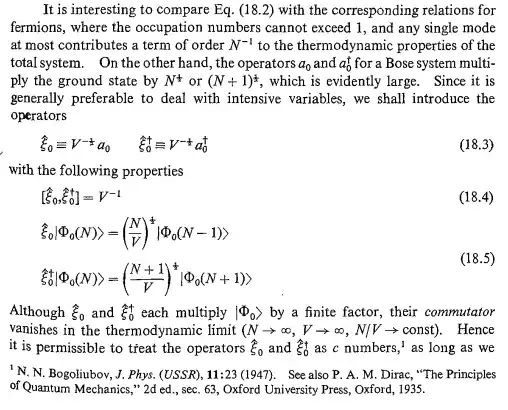My textbook (Advanced QM by Yuli V. Nazarov) defines the Cooper pair creation operator as $$Z_{k}^{\dagger}=c_{k,\uparrow}^{\dagger}c_{-k,\downarrow}^{\dagger}.$$ The text then goes on to show that the BCS hamiltonian takes the form $$H^{(2)}=\frac{U}{V}\left(\sum_{k}Z_k^{\dagger}\right)\left(\sum_{k}Z_k\right)$$ which is then rewritten in the more tractable form $$H^{(2)}=\frac{V}{U}\hat{\Delta}^{\dagger} \hat{\Delta}$$ where we define $\hat{\Delta}\equiv \frac{U}{V}\sum_kZ_k$. when calculating the expectation value of $H^{(2)}$ for the ground state, the author makes a few deductions which I find challenging to understand. First, the author makes the approximation $$\langle \hat{\Delta}^{\dagger} \hat{\Delta}\rangle\approx \langle\hat{\Delta}^{\dagger}\rangle \langle\hat{\Delta}\rangle.$$ I am not sure why this approximation is valid though. The authors reasoning is that " because $\langle \hat{\Delta}^{\dagger} \hat{\Delta}\rangle \propto \sum_{k,k'}\langle Z_k^\dagger Z_{k'}\rangle$, the dominant contribution to the expectation value comes from the terms where $k\neq k'$ , we can safely assume that $\langle \hat{\Delta}^{\dagger} \hat{\Delta}\rangle\approx \langle\hat{\Delta}^{\dagger}\rangle \langle\hat{\Delta}\rangle$ ." I do not understand this reasoning though. Any help in explaining it would be most appreciated.
Secondly, once this approximation has been made, the author then goes on to show that $$\langle H^{(2)}\rangle=\frac{V}{U}\langle \hat{\Delta}^{\dagger} \hat{\Delta}\rangle \approx\frac{V}{U} \langle \hat{\Delta}^{\dagger}\rangle \langle\hat{\Delta}\rangle =\frac{V}{U}|\langle \hat{\Delta}\rangle|^2.$$ I also fail to understand the last equality in the above equation. The author seems to have assumed that $\langle \hat{\Delta}^{\dagger}\rangle=\langle\hat{\Delta} \rangle^{*}$. I can't understand why this assumption is valid. Once again, any help on this would be most appreciated!

